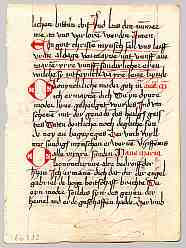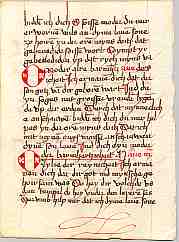

This shows the recto and verso of a leaf from a book of hours of the late 15th or early 16th century. It has a particular interest as a rather downmarket production, indicating the use of these texts by lay people from less elevated classes of society. It is written on paper rather than vellum, as became more common in the late middle ages for more workaday books, or even works which were self penned. The script is a rather irregular and untidy, although perfectly legible, Gothic cursive book hand. The only decoration is in red ink, used for some simple capitals, rubric headings and underlining, and a curly flourish at the bottom of the page.
It is written in the vernacular, but I am really not sure whether it is a variant of Dutch or German. Medieval vernaculars were not highly standardised, so I suspect this represents a regional dialect. Some words appear more like modern German, others like Dutch, and in many cases the spelling is different to both. As with English of this date, it is possible to find the same word spelled in two different ways on the same page. If any of my German or Dutch readers out there can shed any light on this matter, any information would be more than gratefully received.
As I am not an expert on medieval Germanic languages, my so-called translation may be very inexact, but it gives you the general idea. The text is actually a series of prayers to the Virgin Mary, known as the Joys of the Virgin. Each section begins with a reference to an episode in the life of the Virgin, which is then followed by a prayer for the soul of the person praying. This was a common inclusion in books of hours, but the text could vary, as could the number of joys; seven, nine and fifteen being quite common. Latin books of hours produced in France often included the Joys of the Virgin in French, suggesting that this is a more intimate conversation with the Virgin than that implied by the formality of the Latin Hours of the Virgin.
Compared to the very spare standard French text of this series of prayers, this seems to be something of a blood and thunder version of the Joys of the Virgin. It is perhaps not quite so obvious on this leaf, but the following leaf, which is not available to show you, has references to the pains of the fires of hell, and comparisons between the pains and bloody wounds of Christ on the cross with the pains in the heart of a sinner. If this all sounds a bit less than joyful, the moral is that it's all going to come out right in the end. It is difficult not to be reminded of late medieval German carved crucifixes with their emphasis on the suffering mortal Christ as compared to the more benign and stylised French depictions.
| overview | text | alphabet | abbreviations | exercises | transcript | translation |
If you are looking at this page without frames, there is more information about medieval writing to be found by going to the home page (framed) or the site map (no frames).